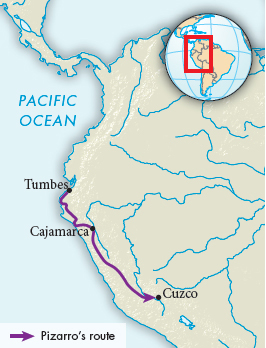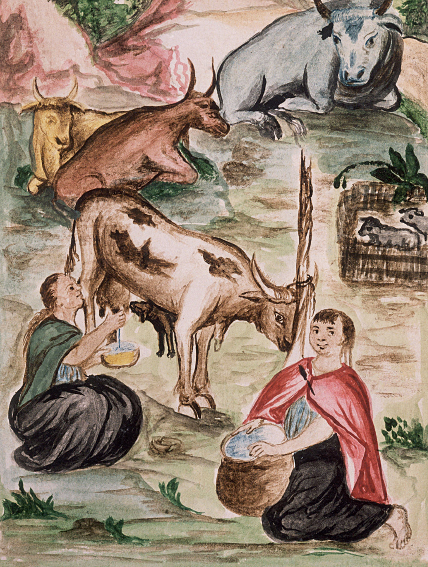Understanding World Societies:
Printed Page 468
Spanish Conquest of the Aztec and Inca Empires
In the first two decades after Columbus’s arrival in the New World, the Spanish colonized Hispaniola, Cuba, Puerto Rico, and other Caribbean islands. Based on rumors of a wealthy mainland civilization, the Spanish governor in Cuba sponsored expeditions to the Yucatán coast of the Gulf of Mexico, including one in 1519 under the command of the conquistador (kahn-
The Mexica Empire, also known as the Aztec Empire, comprised the Mexica people and the peoples they had conquered. At the time of the Spanish arrival, the empire was ruled by Moctezuma II (r. 1502–

Within weeks of his arrival, Cortés acquired translators who provided vital information on the empire and its weaknesses. (See “Individuals in Society: Doña Marina /

Moctezuma’s response to the arrival of the Spanish was weak and hesitant. Unlike other native leaders, he refrained from attacking the Spaniards but instead welcomed Cortés and his men into Tenochtitlan. Moctezuma was apparently deeply impressed by Spanish victories and believed the Spanish were invincible. When Cortés took Moctezuma hostage, the emperor’s influence crumbled. During the ensuing attacks and counterattacks, Moctezuma was killed. The Spaniards and their allies escaped from the city suffering heavy losses. Cortés quickly began gathering forces and making new alliances against the Aztecs. In May 1521 he led a second assault on Tenochtitlan, leading an army of approximately one thousand Spanish and seventy-
The Spanish victory in late summer 1521 was hard-
More remarkable than the defeat of the Aztec Empire was the fall of the remote Inca Empire in Peru. Living in a settlement perched more than 9,800 feet above sea level, the Incas were isolated from the Mesoamerican civilization of the Aztecs. The Incas’ strength lay largely in their bureaucratic efficiency. They divided their empire into four major regions, each region into provinces, and each province into districts. Officials at each level used the extensive network of roads to transmit information and orders. The Incas used a complex system of colored and knotted cords, called khipus, for administrative bookkeeping.

This illustration of Inca women milking cows is from a collection of illustrations by a Spanish bishop that offers a valuable view of life in Peru in the 1780s. (From Codex Trujillo, Bishop Baltasar Jaime Martínez Compañón, Palacio Real, Madrid, Spain/Photo: Albers Foundation/Art Resource, NY)
By the time of the Spanish invasion, however, the Inca Empire had been weakened by a civil war over succession and an epidemic of disease, possibly smallpox, spread through trade with groups in contact with Europeans. The Spanish conquistador Francisco Pizarro (ca. 1475–
Like Moctezuma in Mexico, Atahualpa sent envoys to greet the Spanish. Motivated by curiosity about the Spanish, he intended to meet with them to learn more about them and their intentions. Instead the Spaniards ambushed and captured him, extorted an enormous ransom in gold, and then executed him in 1533. The Spanish then marched on to Cuzco, profiting, as with the Aztecs, from internal conflicts and forming alliances with local peoples. When Cuzco fell in 1533, the Spanish plundered immense riches in gold and silver.
A combination of factors made it possible for tiny Spanish forces to bring down the mighty empires of the Americas: the boldness and audacity of conquistadors like Cortés and Pizarro; the military superiority endowed by Spanish firepower and horses; the fervent belief in a righteous Christian God imparted by the reconquista; division within the Aztec and Inca Empires that produced native allies for the Spanish; and, of course, the devastating impact of contagious diseases among the indigenous population. Ironically, the well-